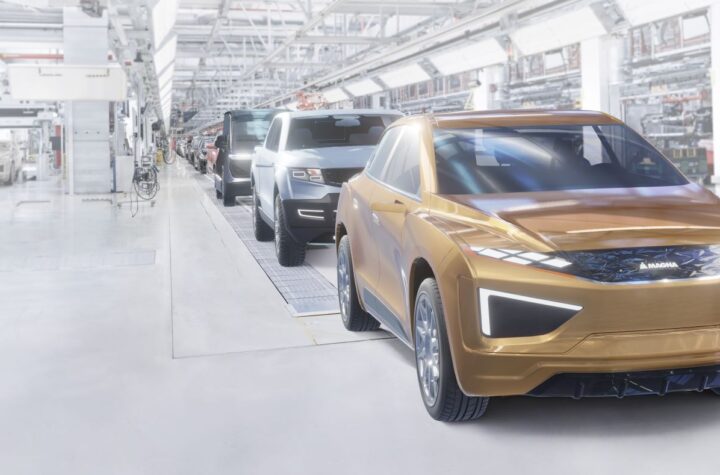
The Big 3 consider the U.S. fertile ground to increase passenger diesel market share, but not just yet.
 |
| Among GM’s 1.7 million diesel engines it produces annually is the popular Duramax diesel engine. |
Volkswagen has demonstrated a North American interest for diesel vehicles smaller than 8,500 gvw — it offers diesel versions of its Jetta, Jetta wagon and Golf, with plans to offer diesel New Beetles — but at this point, it stands alone. If diesels are so popular in Europe, why then are their numbers practically non existent in North America?
Diesel technology has come a long way from the ill-fated attempts in the 1970s and ‘80s to introduce diesel passenger cars. Many consumers in North America have a dated image of the loud, “dirty diesels” first offered here by car makers. But those days are long gone. Today, as proven in Europe, diesels are clean and efficient and offer a performance that is unmatched by a gasoline engine.
“Most people don’t really have a feel for what modern diesels are like because they haven’t experienced them,” says Bernard Robertson, senior vice president for engineering technologies and regulatory affairs at DaimlerChrysler. “The major enablers to making diesel engine systems as slick as they are now have been the advances in control systems, the fuel injection systems, the shift to common rail, very high injection pressures and the increasing sophistication of machining of injection nozzles, together with the high pressures to improve atomization.
“There has been dramatic change in the engine control systems,” Robertson adds. “I’d say we are at a plateau at the moment, where there are a lot of very slick, refined, pleasant high output diesels which all share, broadly speaking, a similar architecture. The engines are comparable, they are all using high-pressure common rail, they are typically all using pilot injection.
“I think that everyone is now on the cusp of the next significant move which will probably be another increase in injection pressure, another refinement in nozzles, and almost certainly multiple pilot injections instead of one pilot injection.”
Gary Smyth, engineering director, GM Powertrain, also cited the growing sophistication of diesel technology. “We are now looking at turbocharged with intercoolers with variable geometry turbines,” he says. “If you look at the performance, we are now up to 60, 70, 80 hp per liter for those engines.”
Though that high-output technology has obviously been successfully demonstrated in Europe, the U.S. still appears to be a few years away from seeing large volumes of under 8,500 gvw diesel vehicles. Besides the daunting task of changing the public’s mind, diesels in North America face other challenges, specifically emissions regulations and fuel issues.
Emissions
 |
| DaimlerChrysler will introduce 5,000 diesel Jeep Liberties to North America in 2004 powered by a DaimlerChrysler-produced 2.8L common rail turbo-diesel. |
In Europe, emissions standards are promulgated through the European Union. In the U.S., the Environmental Protection Agency (EPA) has primary responsibility, but in many cases, follows the lead of the California Air Resources Board (CARB). Because of air quality issues unique to California, CARB has been, in many cases, the tail that wags the emissions dog in North America.
There has been some general movement toward “harmonization” of emissions standards worldwide, but progress toward that goal has not been especially swift. That alone makes it difficult for diesels to freely move between global markets.
“In Europe, when people think clean, they focus on global warming and that is carbon dioxide, which is fuel economy,” says John Koszewnik, director of diesel engines at Ford Motor Co. “And there, diesels have a 30 to 40 percent advantage. In the U.S., the clean thought is led by California, and there, they’re not so worried about global warming. The CO2 they produce goes over the mountain. They’re worried about NOx.”
“Everyone in the world is working on how to reduce NOx and particulates,” adds Robertson. “The popular approaches to particulates are either further improvements in refinements in engine control to reduce the engine-out particulates combined with very clean fuel, or possibly synthetic diesel fuel or biodiesel fuel. Any of those things seems to have the potential to meet the particulate standards.”
Robertson also cites particulate filters to reduce PM, which he says has “obvious merits but also some challenges.”
“It is costly,” he notes, “and you do have to regenerate. You have to find some way to dispose of the particulates. There is no complete consensus on how to do that successfully. And of course, during the time that you are regenerating the filter, potentially you are emitting something and the EPA requires you to measure that.”
Progress has been made, as over the last 10 years particulate emissions have been reduced by about 90 percent in diesel engines in Europe. “There has been significant advancement through combustion improvement,” says Smyth. “Additional improvements can be made and are being investigated through improved combustion. “But also, you are now seeing the introduction of diesel particulate traps, or DPFs.
The DPFs will reduce particulates by another 90 to 95 percent over today’s rail emissions.
So with the introduction of DPFs, the particulate issue basically becomes a non-issue.”
On the NOx side, the most popular candidates are either NOx reduction catalysts or adsorbers, which, according to Robertson, have been demonstrated experimentally. Yet it’s an unproved technology, as no one has successfully demonstrated NOx absorbers with the kind of durability and reliability that would be required for use in the real world. Another emissions reduction candidate is selective catalytic reduction, (SCR) in which a reagent or reductant, such as urea or ammonia, is injected into the exhaust stream, causing a chemical reaction that reduces NOx levels dramatically. These systems have been successfully applied to large, mostly non-mobile engine systems, such as those used power generation. Yet, some point to the addition of the SCR system and the requirement to reload or refill the reagent supply, as drawbacks to applying it to mainstream passenger vehicles.
“The Europeans are quite enthusiastic about urea selective catalysis, and it has been demonstrated that it works,” says Robertson. “People know how it works and why it works and there are systems that have been demonstrated that will successfully meet the very low emissions standard. But the EPA, up to now, has been cautious with its view of those systems. It hasn’t exactly banned them, but it has said it is not at all convinced that it is the way go because it relies on the customer to keep the urea system charged. The EPA doesn’t believe that the general public would necessarily do that.”
According to Koszewnik, a key challenge to diesel is what is done to the basic engine design to reduce NOx emissions. He notes “anything you can’t clean up in the base engine needs some sort of exhaust aftertreatment system that has an efficiency that allows to meet the tailpipe requirements.”
Koszewnik believes that, in terms of diesel exhaust aftertreatment technology, are roughly at a similar stage to where gasoline engines were five to seven years ago. “If you look, you’ll find that we are making major improvements with control strategies and the gasoline engine world that allow to get higher heat fluxes to get quicker light-offs so that we can use reduced amount of precious metals,” he says. “I think are relatively immature in terms of diesel exhaust aftertreatment and that we will find lower cost ways of putting the product out there that will meet the requirements without burdening the customer with costs.”
Fuel
Some argue that fuel — and specifically costs — has a lot to do with the popularity of diesels in Europe. In the U.S, gasoline is cheaper than bottled water and fuel economy isn’t an especially high priority. In Europe, where fuel — and particularly gasoline — is generally much more, the increased miles per gallon offered by a diesel powertrain help offset the price premium associated with opting for a diesel engine.
“In Europe, fuel is close to $4 per gallon,” says Smyth. “Looking at it from an economic standpoint, if you look at the additional cost of a diesel engine, the premium payback time for a car with 30 mpg fuel economy is about 30,000 or 40,000 miles. In North America, because of low fuel costs, you’re looking at 250,000 to get a payback in the extra premium you pay for a diesel vehicle.”
The quality of fuel is another challenge for light-duty diesel engines in North America. The smaller diesel engines that are being used in Europe rely on low sulfur diesel fuel, which is essentially the standard. While it is available on a limited basis in North America, it won’t be widely available in the U.S. until 2006.
“We’ve had a lot of dialogue with the regulatory agencies and with the oil companies,” says Robertson. “We were strong supporters of the EPA’s rulemaking move to require low sulfur gasoline and diesel.
“There is a reluctance to invest when you don’t have to and the oil companies have the same reluctance anyone else does to making an investment if they don’t see a direct return on the investment. There are several oil companies that have started to make available low sulfur fuel. BP has made a commitment to make low sulfur fuel available in 40 cities around the world, with several are in the U.S. and they plan to beat the 2006 deadline.”
Diesels and the Big 3
As the popularity of diesels continues to grow in Europe, the Big 3 are eyeing North America as possibly a fertile new ground for the technology. DaimlerChrysler, a strong proponent of diesels, is the first to put its words to action by announcing plans to introduce a diesel Jeep Liberty and a Mercedes E320 CDI to North America in 2004. DC plans to start with 5,000 diesel Jeep Liberties that will be built in Toledo, Ohio, and a “similar” number of Mercedes E320 CDIs that will be built in Germany.
“We are going to have to increase awareness and create demand,” says Robertson. “We look back at our experience with a Cummins diesel which we put in the Ram pickup. We started out with 10,000 units per year. We do close to 130,000 per year now. That didn’t happen overnight. It gradually built up. The product got better and better and awareness grew. We are tying to start out with a reasonable volume of light duty diesels and go from there.”
While Ford has announced plans to introduce a diesel Focus to North America, the timing of that introduction and the planned volumes are closely guarded secrets.
“We are seriously studying the possibility of bringing a diesel Focus to North America,” says Koszewnik. “Ford produces around 1.1 million diesel engines annually.
“It’s natural that diesels are going to come to the U.S. in high volume in the near future. The manufacturers who are going to ride the wave are going to be successful, just like they were successful in Europe. Ford is riding that wave right now, and we are going to do our best to make sure we ride that wave in North America.” General Motors continues to break new ground in Europe. In December, Opel introduced the new Astra 1.7 CDTI, the first diesel to comply with Euro IV emissions standards. But when it comes to North America, GM says it is not prepared to comment.
“GM has the capacity for about 1.7 million diesels annually,” says Smyth. “As we look at Europe and the Asia pacific, North America is still an unknown as to how successful diesel would be in our market, given those stringent emission standards and give the economics around fuel costs.
“We can introduce a diesel vehicle to North America today,” says Smyth, “the question is can you keep them in production after 2007 (when the next tier of EPA standards is implemented). At this stage, we are putting all of our efforts into development and we are not prepared to make any announcements. We are putting tremendous effort into developing the right systems that would allow us to be in the market beyond 2007.”
“There is a significant opportunity for diesels in the global market,” Smyth says. “The question is can we create a market for North America post-2007 that the customer is prepared to buy?”
Phase Two of Peugeot/Ford Partnership
New HDI/Duratorq TDCI Diesel Engines
 |
| The new 2.0L HDi/ Duratorq TDCi features variable geometry turbocharging from Garrett and Siemens common rail direct injection. |
The 1.6L HDi (PSA)/Duratorq TDCi (Ford) has been derived from the 1.4L HDi (PSA)/Duratorq TDCi unit that has to date been installed in nearly 400,000 cars.
Two versions of the 1.6L unit will be available. The main 110 hp engine offering 177 lbs.-ft. of torque at 1,750 rpm will be followed with an 90 hp unit with 156 lbs.-ft. of torque.
Seventy percent of maximum torque is available at 1,250 rpm thanks to the use of an intercooled Garrett variable geometry turbocharger (VGT), specifically developed for the engine. The 4-cyl., 16 valve engines feature a bore and stroke that has been increased by 1.3 mm and 6.3 mm respectively over the 1.4L parent unit, resulting in a displacement of 1.6L.
The 1.6L engine utilizes a Bosch second-generation fuel injection system. This system helps minimize emissions at the source with an increased maximum pressure of 1,600 bar, combined with small diameter injector nozzles featuring six 0.135 mm inlet ports.
In addition, a wider injection spray angle is deployed in conjunction with an enlarged bowl in the combustion chamber.
The partnership claims the redesigned chamber enables the common rail system to realize the full potential of its multiple injection parameters. More powerful electronic control units combined with new more precise fuel injectors enable up to six injections per engine cycle. Two pilot injections reduce combustion noise, two main injections to reduce NOx emissions, and two post injections to improve regeneration efficiency of the particle filter system.
The 2.0L HDi/Duratorq TDCi is the latest development of the 2.0L family that has equipped PSA Peugeot Citroen mid- and upper-range cars since 1998. It uses the architecture of the DW10 powerplant, and is designed around a cast iron block with an 88 mm x 85 mm bore and stroke topped with a 16-valve aluminum cylinder head.
Substantial efforts were made to reduce the engines height and width to improve the integration of front-end design parameters and ensure better energy dissipation. By comparison with its predecessor, the new engine is 40 mm narrower and 15 to 20 mm shorter, allowing both frontal impact and pedestrian impact design parameters to be met.
With a maximum power of 136hp at 4,000 rpm, the 2.0L HDi/Duratorq TDCi is about 25 percent more powerful than its forerunner, yet offers the same fuel consumption. The new generation Siemens common rail direct injection system on the 2.0L engine features the multiple injection capability, with control of up to six injectors. Injection pressures of 1,600 bar are controlled with piezoeletronic actuators. The cooling system has been fitted with an electronically controlled heat management unit that enables the system to reach maximum efficiency more quickly and reduce fuel consumption.
The 2.0L unit features a Garrett VGT turbocharger that aids the engine in achieving a maximum 251 lbs.-ft. at 2000 rpm.
The engines will be manufactured at PSA Peugeot Citroen’s plant in Tr?mery, in the Moselle region of France where output of the 2.0L engine is scheduled to reach at least 2,300 units per day by 2005. Production of the 1.6L HDi/Duratorq TDCi is expected to reach 1.1 million engines per year by 2005.













More Stories
From Gasoline Powered Cars To Electric Vehicles | Electric Moped Bike A Best Alternative
Rubbernecking: A Silly Reason for Car Accidents
Flexible Magna Manufacturing Solutions: The Key to Success in the Automotive Industry